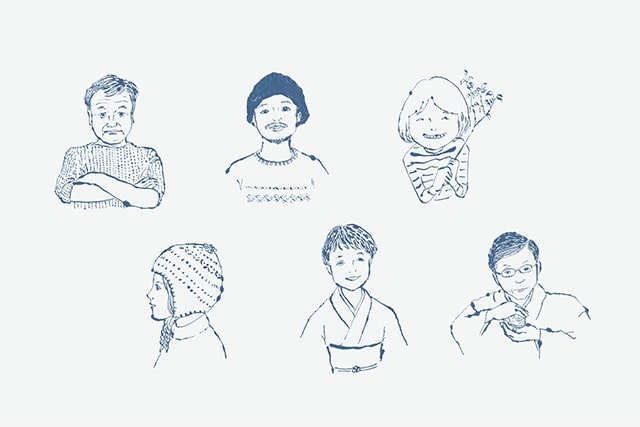
田辺夕子 Yuko Tanabe
Editor, Ginza Hyakuten
It has been more than ten years since I joined Ginza Hyakutenkai, the publisher of Ginza’s local free magazine, Ginza Hyakuten.
As an editor, my main task was to write interview articles on different stores in Ginza, request authors and other renowned people to contribute articles or to join roundtables, on which I would write pieces.
Time has gone by, but even with my job title changed to editor-in-chief, my tasks have not changed at all. Every day, I look for stories around Ginza to publish a small 100-page booklet monthly.
When editors of Ginza Hyakuten send out letters to candidate interviewees or contributing authors, we provide a brief explanation of our booklet – perhaps because it is a unique medium.
The formula that has been passed on from past editors more or less include the following three elements:
“Sixty years of history as the oldest local free magazine in Japan”
“Published by Ginza Hyakutenkai, with a membership of more than one hundred specialty stores in Ginza”
“A booklet that delivers the fragrance of Ginza”
All of a sudden, the description becomes abstract.
What is “the fragrance of Ginza?”
Do all towns have a fragrance that identifies it?
Uncomfortable with the phrase, I once rephrased it to “a booklet that delivers the culture of Ginza” but that didn’t sound right either.
Ever since, I have used “the fragrance of Ginza” without giving it much thought.
Perhaps if I have given it more thought, I would be writing this essay now.
My job has me spending eight hours in Ginza every weekday.
That should serve as an excuse, as insolent as it may sound, for my feeling as though I were at home in Ginza.
It is not until we come home from a long day spent outside that we recognize the unique fragrance of our home.
I will start by exploring “the fragrance of Ginza” based on comments made by people from outside Ginza.
Several years ago, I organized a roundtable on “The Fragrances of Japan” with the participation of CEOs of three long-established incense companies.
Two companies were based in Ginza and one was from Kyoto.
The CEO from Kyoto, who had taken the first Shinkansen from Kyoto to Tokyo said in a soft Kyoto dialect,
“I can smell the sea.”
Ginza is indeed located close to the ocean.
Even Hamarikyu, where the Shogun docked his ship and where he enjoyed the beach, is located in Ginza, Chuo-ku.
Therefore, when the southern winds blow in springtime, we can smell the salty breeze.
Yet, few people would associate the smell of the sea with Ginza.
This owes to the fact that the seascape of Tokyo Bay, like the city itself, has been modernized. Ginza has developed as a modern city since 1872 (Meiji 5), blessed with little nature, including plants and flowers.
Perhaps, cities with constantly renewed infrastructure have no room for fragrances originating in nature or daily life.
Then does the “fragrance of Ginza” refer to the individual scents of the many stores in Ginza?
Ginza Kimuraya’s freshly baked Sakadane Anpan all lined up when the store opens
The piping hot sukiyaki served at Ginza Rangetsu
Torigin’s kamameshi, filling the air with blissful excitement when the lid is opened
The Antique Blend poured from the shining silver coffee pot at Ginza Tricolore……
In addition to these savory aroma, the spacious basement food floor in each department store is filled with the tempting aroma of cooked food from various regions around the world.
There are many other fragrances unique to Ginza:
The smell of high-quality tanned leather bags, including dulles bags, on display at Ginza Tanizawa
The smell of fresh paper from the notebooks neatly lined up at Ginza Itoya
Serge Lutens, a perfume that can only be found at SHISEIDO THE STORE
The scent of the shaving cream used at Yonekura for face shaving (also available for women)……
And the list goes on.
Pleasant or not, it seems to be impossible to determine the “fragrance of Ginza.” (A few years ago, there was much discussion about an apparel brand that let the fragrance of its perfume fill the Ginza-dori for a while after its grand opening.
Every time I walked by the store, I felt as though I was in a large shopping mall in the U.S., so some people may actually have a particular fragrance that reminds them of Ginza.)
Pondering these thoughts, I went to meet my interviewee just after the clock over Wako turned three.
In the 1980s, Ginza-dori was home to branch offices of various banks and the shutters would roll down on both sides of the banking street at this time of day, when over-the-counter business hours end.
From the late 1990s to 2000s, many overseas brands opened stores, and since then the most popular stores of the times, such as fast fashion or duty-free shops for inbound tourists, have tended to expand their businesses into Ginza.
The same may be said about the overseas tourists who come to Ginza.
A couple of years ago, the majority of tourists of tourists were Asian, but today, there appears to be a rush of Indonesian tourists wearing hijabs.
With the 2020 Olympic Games just around the corner, the speed of change has been accelerated, with some stores leaving Ginza and new stores replacing them, eventually blending into the townscape of Ginza.
Far from of being conservative, Ginza is always open to change and to renewing its history.
GINZA SIX is symbolic of the recent changes in Ginza.
As I approached GINZA SIX, I found standing in between a foreign brand store and a duty-free shop for inbound tourists, an authentic Japanese restaurant. This picture is often seen in Ginza.
Walking past the hanging door sign saying “Getting ready, ” I noticed a familiar scent of sandalwood.
I instantly recognized the incense from the store in Kyoto that participate in the roundtable.
Many restaurants take a break at this time of day between lunchtime and dinnertime.
Perhaps the restaurant was burning incenses to prepare itself for the evening when diners take time indulging in the food and drinks, whereas at lunchtime, the restaurant becomes filled with lively conservation among women diners.
My destination was a bar located near the corner of Miyuki-dori.
A bartender, quite young to own a bar in Ginza, runs the small bar with only a few seats at the counter on his own. I arrived punctually at 3:30 pm, to interview him before business hours.
As I walked down the stairs to the bar located on the basement floor, I was welcomed by an Oriental scent, which by chance was the same as that familiar scent from the Japanese restaurant.
I opened the door to find the bartender wearing an apron, cleaning every corner of the room, with all the stools on the counter.
He was burning incenses in the washroom, with door wide open.
By the time we were finished with the interview, and he prepared himself and his bar to welcome his first customer of the evening, the scent would have become a faint fragrance barely recognizable.
Ginza is a place where all stores have a subtle way of welcoming its customers that is not as obvious as “omotenashi.” That feeling can be expressed in various ways unique to each store, not necessarily by burning incenses.
Perhaps that is the true identity of the “fragrance of Ginza.”
Written by Yuko Tanabe, Editor Editor-in-chief of Ginza Hyakuten, Japan’s oldest local free magazine founded in 1955 as “a magazine that delivers the fragrance of Ginza.”
- Essay 01 Scents from my childhood: Kengo Kuma
- Essay 02 The true identity of the fragrance of Ginza: Yuko Tanabe
- Essay 03 “A free place” created by the aroma of coffee」:Daisuke Matsushima
- Essay 04 “Fragrances” visible in photos: Kasane Nogawa
- Essay 05 Memories of the smell of fire: Eriko Hirano
- Essay 06 A “Great Scent” rises in Ginza: Yoshihiro Inasaka


